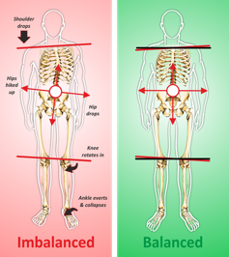The kinetic chain
To take care of your hips and knees, it’s important to understand how they interact. Your body forms something known as the kinetic chain, starting at your ankles all the way up to your neck. The knee joints are connected directly to the hip joints in this chain, with a change in one often leading to a change in the other.

Knee pain is most often the result of repeated strain/stress on the knee, usually due to a malposition of the knee. When the knee is out of alignment this way, even if it’s only slight, it can lead to a tilt in the hip and pelvis, causing a “kinetic chain reaction” that leads to pain across your body, in particular your hips.
Put simply, misaligned knees = misaligned hips.
Straightening it all up
Hip pain caused by knee issues often starts with stiffness and aches in the groin and thighs closer to your hips. that come and go. From here, it can start to lead to more muscle pain and issues in the lower back as well. If left untreated, it can throw off your shoulders, too. To make sure not only your knees and hips but the rest of your body are taken care of, taking care of the cause of the pain is crucial. Treating the pain alone won’t help your body long-term.
Here are three key ways to care for your kinetic chain for a happy and healthy body from head to toe.
From the feet up
Your kinetic chain starts at your feet and getting your foot and ankle posture right makes a world of difference to your knees and hips. With more than two-thirds of the adult population suffering from flat feet or high arches, correcting the foot posture often provides significant relief. We have a range of insoles for any foot and lifestyle.
Wearing suitable footwear that properly supports you in active movement also helps a lot in this regard.
Support the knees
Using a medical knee support often makes the difference in effective and lasting recovery from injury. Whether it’s a mechanical hinged support to stabilise the joint, or special gel pads with compression to help the muscles in the knee support and guide the knee properly, finding the right knee support will help your knees, hips and the rest of your body.
Right on target
While supports and insoles help, physiotherapy and clinical help are always recommended for those who have been dealing with ongoing pain or have previous injuries. By having a physiotherapist or other clinician assess your body properly and work with you, they can help provide targeted exercises to strengthen and realign your body to take care of pain, knees, hips, and all.
Read more: Foot pain while running? Treatment tips




















